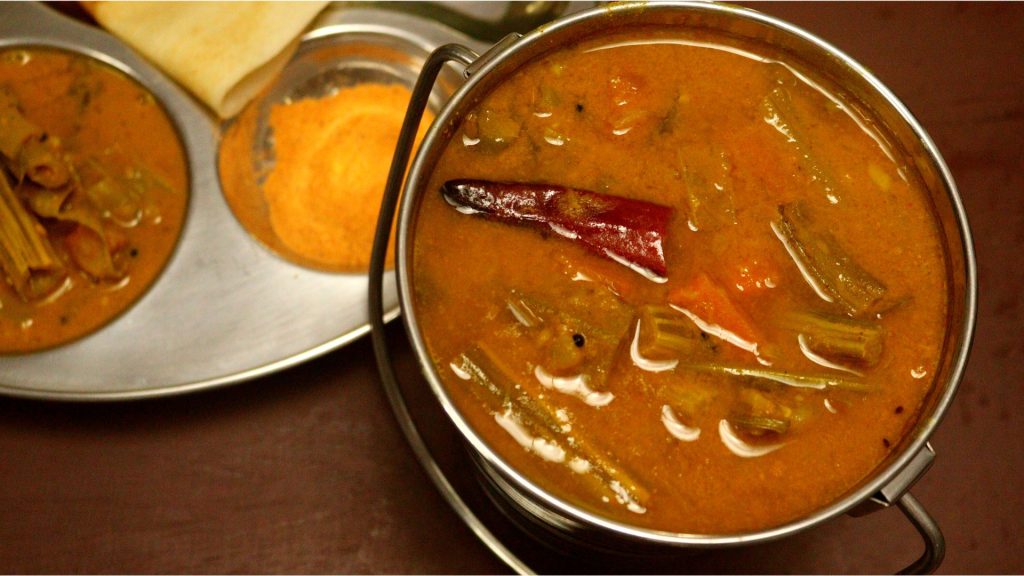



Sambar recipe in restaurant style is a South Indian dish typically eaten with dosa, idli, or vada. It is a lentil and vegetable soup cooked in tamarind water and seasoned with spices.
The word "sambar" comes from the Tamil word "samba," which means to mix. Sambar is usually made of vegetables and lentils. For example, it can be made of drumstick pods, tomatoes, onions, garlic, ginger, and dry red chilies. The main ingredients are dal (lentils), tamarind (or kokum), asafoetida (hing), coriander powder, Kashmiri red chili powder, turmeric powder, etc. The proportion of vegetables to lentils varies according to regional tastes.
Sambar can be made in a pressure cooker or in a saucepan on the stovetop.
Sambar is a traditional South Indian dish that is made with a combination of lentils and vegetables cooked in a spiced, tamarind-flavored broth. It is one of the most popular dishes in India, enjoyed by people from all over the country.
What makes sambar unique is its versatility - it can be made with different types of lentils, vegetables, and spices depending on the region or preference. Additionally, it can be served as a main course or as an accompaniment to other dishes. With so many variations available, each sambar recipe has something special to offer.
This article will provide an overview of sambar and discuss how to make restaurant-style sambar at home using traditional ingredients and techniques. We will also explore some popular regional variations such as South Indian style sambar dal recipe and more!

Sambar is one of the most popular South Indian dishes. It is a delicious lentil-based dish usually served with steamed rice or idli. If you are looking for an easy and quick way to make restaurant-style sambar at home, then this step-by-step guide will help you prepare it in no time. This sambar recipe in restaurant style uses simple ingredients that can be easily found in any kitchen and the detailed steps will help you create a delicious and flavourful sambar every time. So, let’s get started!
To a pressure cooker add ½ cup toor dal rinsed and soaked, 25 shallots, 10 garlic cloves, 3 green chilis, curry leaves, 1 potato, 2 carrots, and 7 beans.
Pour water 6-7 cups into the pressure cooker then add salt, and ½ tsp turmeric powder.
Mix well, cover, and cook up to 2 whistles. Open once the pressure is fully released
For making masala for sambar, heat a frying pan on medium flame and add 1 tsp peppercorns, ½ tsp fenugreek seeds, 2 tbsp urad dal, and ½ tsp cumin, and dry roast in medium flame for 1 minute.
Then add 6 garlic cloves, curry leaves, 1 cup grated coconut, and coriander leaves to the same pan. Roast on medium flame until it's golden brown.
At this stage add the seasoning, add ½ tsp turmeric powder, 2 tsp Kashmiri chili powder, and 7 tsp coriander powder, and saute until the raw smell of spices goes off. then add 2 tsp coconut oil again, saute well, switch off the flame and allow to cool. Sambar masala is ready.
After making sambar masala, to a bowl add ¼ cup tamarind, and ½ cup water, squeeze out and extract pulp as much as possible and set aside.
Once the pressure is fully released, open the pressure cooker. The dal and veggies are cooked enough. Now let's add the remaining vegetables (veggies with less cooking time) 2 whole drumsticks, 2 tomatoes, and 6 ladies' fingers.
Simmer and cook for 5 minutes. Meanwhile, let's grind the masala. add masala to a grinding jar pour ¼ cup water and blend to a smooth paste.
Once veggies turn soft, Add the masala paste to the pressure cooker, stir well and allow to simmer.
Pour ½ cup water into the grinding jar to remove excess masala. Pour it into the pressure cooker.
Pour tamarind pulp into the cooker through a strainer, add the required salt, a bunch of coriander leaf, and ½ tsp asafoetida. Mix well allow to simmer for 5 minutes and add a small piece of jaggery to balance the sourness. (jaggery can also be replaced with ½ tsp of sugar).
Simmer and cook until the veggies turn soft. Meanwhile, Let's make tadka, heat a tadka pan on medium flame and add 2 tsp oil, 1 tsp mustard seeds, 2 dry red chilis, and curry leaves. Swirl around and pour over the sambar.
Finally, the delicious restaurant-style homemade sambar is ready to serve. Enjoy with dosa or idli or rice.